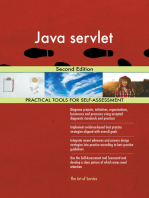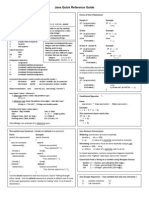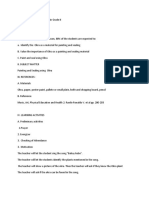Java Quick Reference Guide
Uploaded by
kaz92Java Quick Reference Guide
Uploaded by
kaz92Java Quick Reference Guide
Arithmetic Operators + Addition Subtraction / Division (int / floating-point) 2/3 = 0, 2.0/3.0 =.666667 * Multiplication % Modulus (integer remainder) Relational Operators < Less than <= Less than or equal to > Greater than >= Greater than or equal to == Equal to != Not equal to Logical Operators ! NOT && AND || OR Assignment Operators = simple assignment += addition/assignment -= subtraction/assignment *= multiplication/assignment /= division/assignment %= modulus/assignment
Last Update: Friday, February 8, 2013
Forms of the if Statement Simple if
if (expression) statement;
Remember to use the methods equals( ) or compareTo( ) when comparing Strings rather than relational comparison operators. String s1 = "abc", s2 = "def"; String Comparisons: Compare for equality: s1.equals(s2) or s1.compareTo(s2) == 0 Remember the compareTo( ) method returns one of 3 values: neg number, pos number, 0 Compare for lexical order: s1.compareTo(s2) < 0 (s1 before s2) s1.compareTo(s2) > 0 (s1 after s2) Remember to distinguish between integers and real numbers (called floating-point in Java). These are stored differently in memory and have different ranges of values that may be stored. integers: floating-point: 2, 3, -5, 0, 8 2.0, 0.5, -3., 4.653
Example
if (x < y) x++;
if/else
if (expression) statement; else statement;
Example
if (x < y) x++; else x--;
The "expression" in the parentheses for an if statement or loop is often also referred to as a "condition"
if/else if (nested if)
if (expression) statement; else if (expression) statement; else statement;
Example
if (x < y) x++; else if (x < z) x--; else y++;
To conditionally execute more than one statement, you must create a compound statement (block) by enclosing the statements in braces ( this is true for loops as well ): Form
if (expression) { statement; statement; }
Example
if (x < y) { x++; System.out.println( x ); }
Increment/Decrement ( used in prefix and postfix modes ) ++ Increment prefix - inc(dec) variable, use in larger expression -Decrement postfix - use in larger expression, inc(dec) variable Object Creation: ( new ) new int[ 10 ], new GradeBook("CIS 182") The new operator creates an object and returns a reference (address of an object) Java Types [value/reference ] A value type stores a value of a primitive type int x = 3; A reference type stores the address of an object Circle c = new Circle(2); A reference variable is created using a class name: GradeBook myGradeBook; Primitive Data Types ( Java value types ) Remember: String is a reference type boolean flag / logical true. false [ boolean literals ] char character 'A', 'n', '!' [ char literals ] byte, short, int, long integral 2, 3, 5000, 0 [ int literals ] float, double floating-point 123.456, .93 [ double literals ] Default numeric literal types: integral: int floating-point: double int x = 3; double y = 2.5; //3 is an int literal //2.5 is a double literal
Input using Scanner class Scanner input = new Scanner ( System.in ); //keyboard input input methods: next(), nextLine(), nextInt(), nextDouble() Output methods for System.out or PrintWriter objects print(), println(), printf() [formatted output] Input/Output using JOptionPane class [ package javax.swing ] String numString; int num; numString = JOptionPane.showInputDialog("Enter a number"); num = Integer.parseInt(numString); JOptionPane.showMessageDialog(null, "Number is " + num); Conversion from a String to a number using Wrapper Classes
double d = Double.parseDouble(dString); float f = Float.parseFloat(fString); int j = Integer.parseInt(jString);
The switch/case Construct ( break and default are optional ) Form: switch (expression) { case int-constant : statement(s); [ break; ] case int-constant : statement(s); [ break; ] [ default : statement; ] } } Example: switch (choice) { case 0 : System.out.println( You selected 0. ); break; case 1: System.out.println( You selected 1. ); break; default : System.out.println( You did not select 0 or 1. );
Java formatted output [ printf( ) and String.format( ) methods ] 3 components: format string and optionally: format-specifiers ( fs ) and an argument list ( al ) fs: " ... % [flags] [width] [precision] format-specifier ... " al: comma separated list of expressions Format-specifiers: s (string), d (integer), f (floating-point) Example: System.out.printf("Total is %,10.2f\n", total); Java Numeric Conversions: Widening conversions are done implicitly. double x; int y = 100; x = y; // value of y implicitly converted to a double. Narrowing conversions must be done explicitly using a cast. double x = 100; int y; y = (int) x; // value of x explicitly cast to an int In mixed expressions, numeric conversion happens implicitly. double is the highest data type, byte is the lowest.
The "expression" and int-constant are usually type int or char. Java SE 7 adds the ability to use of a . Use the break keyword to exit the structure (avoid falling through other cases). Use the default keyword to provide a default case if none of the case expressions match (similar to trailing else in an if-else-if statement).
Java Quick Reference Guide
The while Loop ( pre-test loop ) Form:
init; while (test) { statement; update; }
Last Update: Friday, February 8, 2013
The for Loop ( pre-test loop ) Form:
for (init; test; update) statement; for (init; test; update) { statement; statement; }
Example:
x = 0; while (x < 10) { sum += x; x++; }
Example:
for (count=0; count<10; count++) System.out.println ( count ); for (int count=1; count<=10; count++) { System.out.print( Count is " ); System.out.println( count );
} Operator Precedence
'\n' '\t' '\"' '\'' '\\' ( ) ---------*, /, % ---------+, -
The do-while Loop ( post-test loop ) Form:
init; do { statement; update; } while (test);
Example:
x = 0; do { sum += x; x++; } while (x < 10);
Escape Sequences Special characters in Java
\n \t \" \' \\
newline character tab character double quote single quote backslash
[ mathematical ]
Logical operators: !, &&, || (1) mathematical (2) relational (3) logical
Selection and Loop Structures Selection: Unary or single selection Binary or dual selection Case structure possible when branching on a variable Simple selection One condition Compound selection Multiple conditions joined with AND / OR operators Looping: Java Pre-test loops Test precedes loop body while for Java Post-test loop Test follows loop body do-while Loop Control: 3 types of expressions that are used to control loops: initialization ( init ) test update Counter-controlled loops, aka definite loops, work with a loop control variable (lcv) Sentinel-controlled loops, aka indefinite loops, work with a sentinel value Java Loop Early Exit: break statement Note: The break statement can be used with a switch statement or a loop in Java. Loops may also use a continue statement.
Java Arrays:
Create an array ( 2 ways )
1. <type> <array-name>[ ] = new <type>[size]; 2. <type> <array-name>[ ] = { <initializer-list> };
Use the ArrayList class to create a dynamically resizable array. The Arrays class has static methods that can be used with arrays and ArrayLists to search, sort, copy, compare for equality, etc. int num[ ]; <stmts> . Create a new initialized array and assign to num. num =new int[ ]{1.2.3.4.5};
//create an array of 20 elements.
int myArray[ ] = new int[20];
//create an array of 3 elements set to the values in the initializer list.
int myArray[ ] = { 1, 2, 3 }; String stooges[ ] = { "Moe", "Larry", "Curly" };
//assign value of first element in myArray to the integer variable x.
int x = myArray[0];
//assign value of the last element in myArray to the integer variable y.
int y = myArray[ myArray.length-1 ];
All arrays have a public field named length which holds the number of elements in the array. Given this declaration: int x[][][]; x.length x[m].length x[m][n].length is the number of elements in the array in the first dimension. is the number of elements for a specific array in the second dimension. is the number of elements for a specific array in the third dimension.
Java Methods: <type> <method-name> ( [ <type> parameter1, [ <type parameter2, ] ] ) Simple procedural programs in Java will contain the static keyword and may also contain the keyword public. Methods that will not return a value will have the return type void in the method header. public static void printHeadings( ) //no parameters, return type is void { <method body> } static void printDetailLine( String name, int number, double gpa ) //3 parameters, return type is void { <method body> } Math.PI 3.141592635 int getCount( ) //no parameters, return type is int { <method body> } public double max( double x, double y ) //2 parameters, return type is double { <method body> } When a method is called, the data is passed to the parameters (if any) using arguments //Arguments: "Jack Wilson", 100, 3.50 passed to Parameters: name, number, gpa for Method: printDetailLine (see method header above) : printDetailLine( "Jack Wilson", 100, 3.50); A method may be declared with one variable length parameter. It must be the last parameter declared. The syntax of the declaration is <type>... <parameter-name>. Examples: int... numbers, double... values, String... names
//implicit array creation
You might also like
- Dettol: Marketing Research For Understanding Consumer Evaluations of Brand ExtensionsNo ratings yetDettol: Marketing Research For Understanding Consumer Evaluations of Brand Extensions18 pages
- Learn Java - Object-Oriented Java Cheatsheet - Codecademy PDFNo ratings yetLearn Java - Object-Oriented Java Cheatsheet - Codecademy PDF8 pages
- Notes On JAVA 10.2005.3: Syntax of CommandsNo ratings yetNotes On JAVA 10.2005.3: Syntax of Commands3 pages
- Java Information Sheet: Syntax vs. Semantics vs. Style KeywordsNo ratings yetJava Information Sheet: Syntax vs. Semantics vs. Style Keywords8 pages
- How To Install JDK 8 (On Windows, Mac OS, Ubuntu)No ratings yetHow To Install JDK 8 (On Windows, Mac OS, Ubuntu)11 pages
- Unit 1 A Closer Look at Methods and Classes100% (2)Unit 1 A Closer Look at Methods and Classes21 pages
- Learn Java Programming: The Definitive GuideNo ratings yetLearn Java Programming: The Definitive Guide18 pages
- Java Basics (Continued) : Mr. Smith AP Computer Science ANo ratings yetJava Basics (Continued) : Mr. Smith AP Computer Science A27 pages
- Unit Testing With JUnit 5 - Course GuideNo ratings yetUnit Testing With JUnit 5 - Course Guide18 pages
- Parallel Functional Programming in Java 8No ratings yetParallel Functional Programming in Java 855 pages
- Java Program To Check Whether A Number Is Even or Odd (If-Else & Ternary)No ratings yetJava Program To Check Whether A Number Is Even or Odd (If-Else & Ternary)2 pages
- MCTS 70-515 Exam: Web Applications Development with Microsoft .NET Framework 4 (Exam Prep)From EverandMCTS 70-515 Exam: Web Applications Development with Microsoft .NET Framework 4 (Exam Prep)4/5 (1)
- Java Quick Reference Guide: String ComparisonsNo ratings yetJava Quick Reference Guide: String Comparisons2 pages
- Java-Quick-Reference-Guide-bscs-bahria UniversityNo ratings yetJava-Quick-Reference-Guide-bscs-bahria University2 pages
- Funadamental Programming structures in JavaNo ratings yetFunadamental Programming structures in Java88 pages
- Human Resources and Information TechnologyNo ratings yetHuman Resources and Information Technology4 pages
- Philosophy Of Language A Contemporary Introduction William G Lycan instant download100% (1)Philosophy Of Language A Contemporary Introduction William G Lycan instant download77 pages
- Civil Appeal No. 290 of 2023 Consolidated With Civil Appeal No. E328 of 2023No ratings yetCivil Appeal No. 290 of 2023 Consolidated With Civil Appeal No. E328 of 202354 pages
- Traditional Inuit Education - Teaching Guide FinalNo ratings yetTraditional Inuit Education - Teaching Guide Final68 pages
- Psychology - Several Theories and Research Results Related To Attraction and LikingNo ratings yetPsychology - Several Theories and Research Results Related To Attraction and Liking2 pages
- (Critical Africana Studies) Tendayi Sithole - Steve Biko - Decolonial Meditations of Black Consciousness-Lexington Books (Rowman & Littlefield) (2016) (Z-Lib - Io)100% (1)(Critical Africana Studies) Tendayi Sithole - Steve Biko - Decolonial Meditations of Black Consciousness-Lexington Books (Rowman & Littlefield) (2016) (Z-Lib - Io)225 pages
- Artificial Intelligence in Customer Relationship ManagementNo ratings yetArtificial Intelligence in Customer Relationship Management2 pages
- The Scarlet Letter Character Analysis PaperNo ratings yetThe Scarlet Letter Character Analysis Paper2 pages
- Slides and Practice Exams PMP Exam Power Prep91% (11)Slides and Practice Exams PMP Exam Power Prep978 pages






























































































